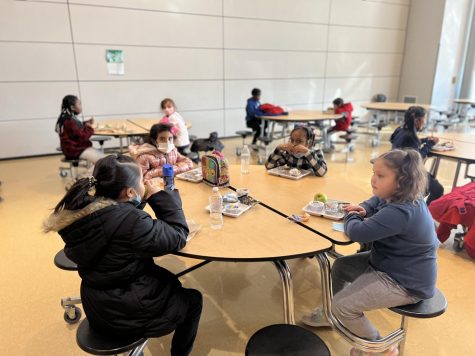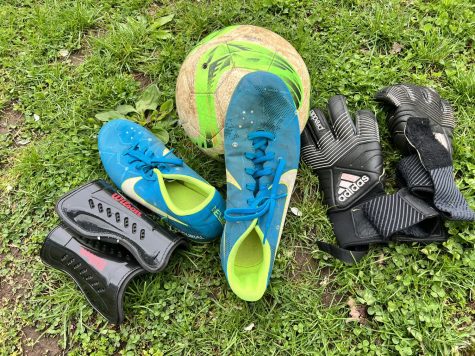What Happened to Fun, Social Lunchtime? Covid Rules.
The cafeteria at East Rock Community & Cultural Magnet School has never been so quiet — at least not when school was in session. But Covid has changed that.
Students remember lunchtime in the cafeteria as one of loudest times of the day. Friends would have yell to talk across a table. The seats were always filled. When one student left, another sat down with their lunch.
School is back in person this year. But East Rock School students say the cafeteria and lunchtime is not “normal.” The East Rock Record Fall 2021 survey found that 35 percent of students said lunchtime is quieter than before the pandemic.
Students must wear masks and sit in groups of four at tables that once held eight. They may remove masks to take a bite of food, but must quickly re-mask. The capacity in the cafeteria has changed. There are 22 tables and now only four are allowed at each table, much lower than in the past. The volume of conversation is softer. When excitement builds, lunchroom monitors rush to keep students quiet.
It has been hard, said Sabrina Breland, principal at East Rock School.
“It’s carrying a lot of stress for everyone involved,” she said. “Students want to talk to their friends. They want to get closer.”

The Covid rules for cafeteria limits have many students eating lunch in their classrooms, said Ms. Breland. When the weather is nice, some classes go outside to eat.
Nora Matz, in sixth grade, said that they have to wait for every sixth grader to get food before students can go up to their classrooms. Ms. Matz said that is it “annoying-ish” and “it creates a lot of confusion and noise.”
When lots of students wait with trays of food and then have to carry them upstairs, students get into conflicts. “There have been a lot of arguments,” said sixth-grader Elias Plascencia. He has seen fights break out when students have spilled food going up the stairs. Other students said they have seen the same thing happen.
In the cafeteria, many students say lunch is quieter than it used to be. Some students also say that lunch monitors are stricter with students and do not allow talking while masks are down.
Ms. Breland told East Rock Record reporters that staff often have to remind students to re-mask. “It’s hard for students to remember to pull their masks over their mouths after they lower them to eat,” she said.
This “new normal” lunchtime has been hard to get used to. Students want to see their friends, but they are stuck in small groups, said Kristen Hebert, who teaches third grade at East Rock School.
“I feel bad for them, because I think you should get to be a kid and I think lunch is one of those times,” she said. “Kids want to talk to each other.”
With the pandemic still a reality, Ms. Hebert said that teachers must stick to the rules and cannot let students gather in large groups.
William Brady, a computational social psychologist at Yale University, told East Rock Record reporters that having fewer opportunities for social interaction could affect students’ mental health. He said that limiting chances for social release could even make it harder for students to concentrate.
“We have a consistent desire for human connection,” said Dr. Brady.
Lunch has always been an important social time during the school day for students and for teachers. The new rules have made it harder on teachers and staff, said Ms. Breland. She said in-classroom lunches have taken away time that once gave teachers a break. As students played, she said, teachers had thirty minutes to reset.
“Teachers want their unencumbered lunchtime back,” she said. “They used this to re-energize themselves.”
Eating in classrooms has also created problems for the cafeteria staff. Ms. Breland said that school lunches must be served to students at a certain temperature. Trying to serve meals hot when students are eating in classrooms, she said, has been “stressful.”
Classroom lunch has also made more work for custodians. With more places for students to eat food, there are more spaces that must be cleaned every day, said Ms. Breland.
Even though lunch is not as lively as it used to be, Covid safety protocols are not going away soon. Keisha D. Redd-Hannans, assistant superintendent for instructional leadership for the New Haven Public Schools said the district worked with the city health department to create the rules based on CDC guidelines. The guidelines, she said, will change when the CDC changes its recommendations.

There was some flexibility. Ms. Redd-Hannans said the district worked with each school to come up with specific plans for how lunchtime would work. In some schools, the district installed dividers in cafeterias. The district also decided to let students eat outside when weather permits, a policy that Ms. Redd-Hannans said could become permanent.
In some schools, all lunch moved to classrooms. She said the district will rely on guidance from the New Haven Health Department and the CDC to decide when social distancing rules can be loosened.
As a former New Haven student herself, Ms. Redd-Hannans remembers enjoying lunch. It’s hard, she said, to see students missing this social time.
“It’s awkward watching our kids with masks on,” she said. “It’s difficult. I’m so proud of students for doing what they do to help us all be safe.”
Ms. Breland agreed. She suggested a reward when it becomes possible.
“As soon as this pandemic is over, we’re going to be the first ones back to normal,” Ms. Breland said. “And we’re going to have a big party.”
Edited by Emiliano Tahui Gómez.





